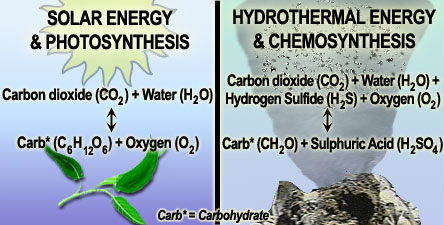
Scientists once thought that sunlight was source of energy for all life and that photosynthesis was the only way to make food. It is now known that reduced chemicals from hydrothermal vents provide chemosynthetic energy for some lifeforms. High temperatures and high concentrations of dissolved minerals in seawater form compounds such as hydrogen sulfide. In a biochemical process, bacteria oxidize hydrogen sulfide and use the liberated energy to produce carbohydrates (i.e., stored chemical energy). Unlike photosynthesis, chemosynthesis requires no light and can occur at the extreme temperatures and high pressures of the deep ocean. The chemosynthetic food web supports dense populations of uniquely-adapted organisms.

- Some organisms cannot draw energy from the sun and must find other energy sources to live
- Both photosynthesis and chemosynthesis are means of producing carbohydrates
- Photosynthetic organisms use light as their energy source; chemosynthetic organisms use chemicals
- As organisms thrive in a given environment, their by-products create a new environment where new species can succeed
- Add about four grams of CaSO4 to enough mud to fill one graduated cylinder to a depth of about 8.0 cm (3.2 inches). Dump the mixture into a jar or beaker and stir it thoroughly with the stirring rod.
- Place the straw or filter paper in the jar with the mud and mix gently. (It may help to add some pond/swamp/sea water here to ease stirring.)
- Transfer the mixture back to the cylinder and add pond or seawater so that the mud is covered with at least 8 centimeters (3.2 inches) of water.
- Add to the cylinder 0.2 grams of baking soda and one crushed vitamin pill. Stir again to make sure all the air bubbles are gone.
- Set the cylinder aside for 30 minutes to settle.
- After 30 minutes, if more than two centimeters (0.8 inches) of water have pooled at the top, pour off all but one centimeter (0.4 inches). If there is less than one centimeter of pooled water on top, add pond/swamp/sea water.
- Repeat steps (1) through (6) for the other graduated cylinder.
- Label the cylinders with the students' names.
- Place one graduated cylinder in a darkened area where it will not be disturbed for at least six weeks. Place the second cylinder under the light source. (You may wish to store both set-ups in the same area with one cylinder in a box. This will help to keep both in similar conditions.)
- Record smell, color, number of layers of mud, or any other observations.
- For at least six weeks, examine the columns weekly and look for signs of bacterial growth. You may wish to use a safety light (flashlight covered with red cellophane) to examine the columns being grown in the dark. Record your observations.
- Bacteria that use light as their major energy source with some hydrogen
sulfide are heterotrophic. Bacteria that use hydrogen sulfide for energy
in the absence of light are chemotrophic.
- Are the bacteria in your well-lit and darkened columns similar? Based on your results and the description above, can you distinguish which bacteria are heterotropic? Chemotrophic?
- Discuss how the by-products created by some types of bacteria were
used by other types of bacteria that then became the dominant species.
(This process is called "succession.")
- Can the students name other examples of "species succession"?
- (OPTIONAL) At the end of the third week take samples for microscopic wet mounts observation from the following locations: (1) surface layers of water, (2) surface layers of the mud, (3) colored layer from the mud. Try using a pipette and be careful not to disturb the column. Observe the wet mounts under high-power magnification, looking for cell shapes that would indicate the types of organisms present.






